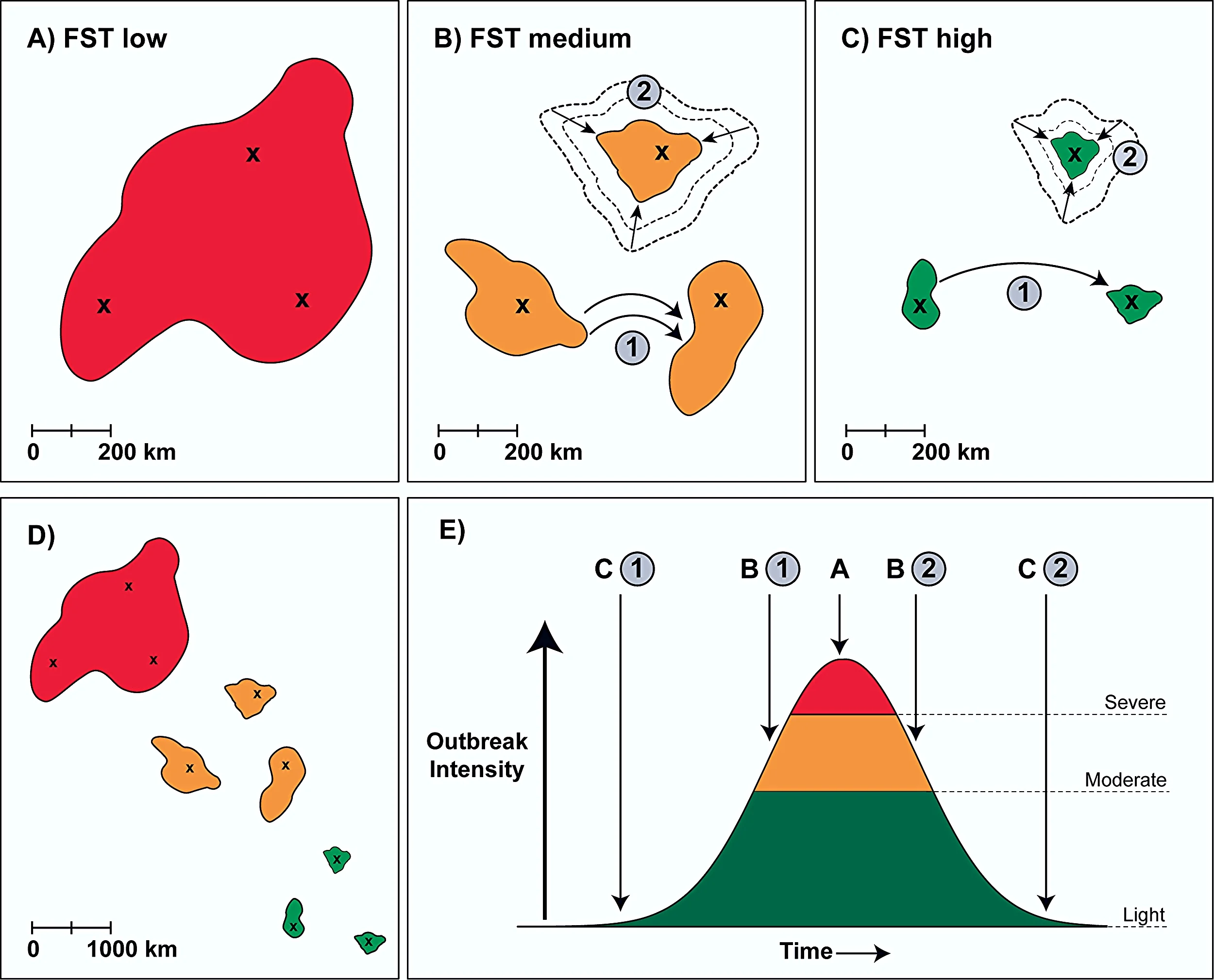Fire-Insect Interactions
Canada’s boreal and mixed-wood forests are dynamic ecosystems shaped by multiple disturbances, including wildfires, insect outbreaks, and forest harvesting. These disturbances interact in complex ways, altering forest fuels and vegetation composition, which directly affect ecosystem structure and function.
Outbreaking insects such as the eastern spruce budworm (SBW; Choristoneura fumiferana), jackpine budworm (JPBW; Choristoneura pinus), and the mountain pine beetle (MPB; Dendroctonus ponderosae) can significantly modify forest fuels, ultimately influencing fire activity, including fire occurrence, behaviour, and outcomes (i.e., burn severity). While it is generally accepted that forest insects impact fire activity, the precise mechanisms of this influence and its variability over space and time remain uncertain.
The anticipated northward expansion of multiple species of forest insect pests, combined with projected climate-related increases in forest fire activity in the boreal forest, introduces significant uncertainty regarding future disturbance interactions. This uncertainty extends to their effects on forest composition and connectivity, ecosystem services, and well as human health and safety.
In this research theme, we aim to gain a deeper understanding of the spatial and temporal dynamics of these critical disturbance interactions, and their implications for managing Canada's boreal and mixed-wood forests. Using multiple approaches that combine field observations, remote sensing (e.g., LiDAR), statistical analysis, machine learning, and simulation modelling, we are investigating how changing fuel complexes are affecting fire behaviour, severity, and landscape resilience.
Recent work in this theme identified an important relationship between fire ignition probability and historical SBW defoliation. Specifically, we found that SBW outbreaks generally increase the risk of ignition 8-10 years after defoliation but decreases this risk immediately following defoliation (within1 year). Building on these findings, we are currently investigating the impact of SBW and JPBW outbreaks on fire suppression, area burned, and fire severity, as well as the underlying mechanisms driving these interactions between forest structure and wildfire. A particular focus of this work is using terrestrial LiDAR to quantify fuel structure and better understand the outbreaks’ impacts to fire behaviour.
The long-term goal of our research in this theme is to develop evidence-based tools and recommendations for managers to proactively address the impacts of insect outbreaks, changing fire regimes, and their interactions. A better understanding of these disturbance linkages is crucial for maintaining ecosystem function and resilience of Canada's boreal and mixed-wood forests in the face of a rapidly changing climate.
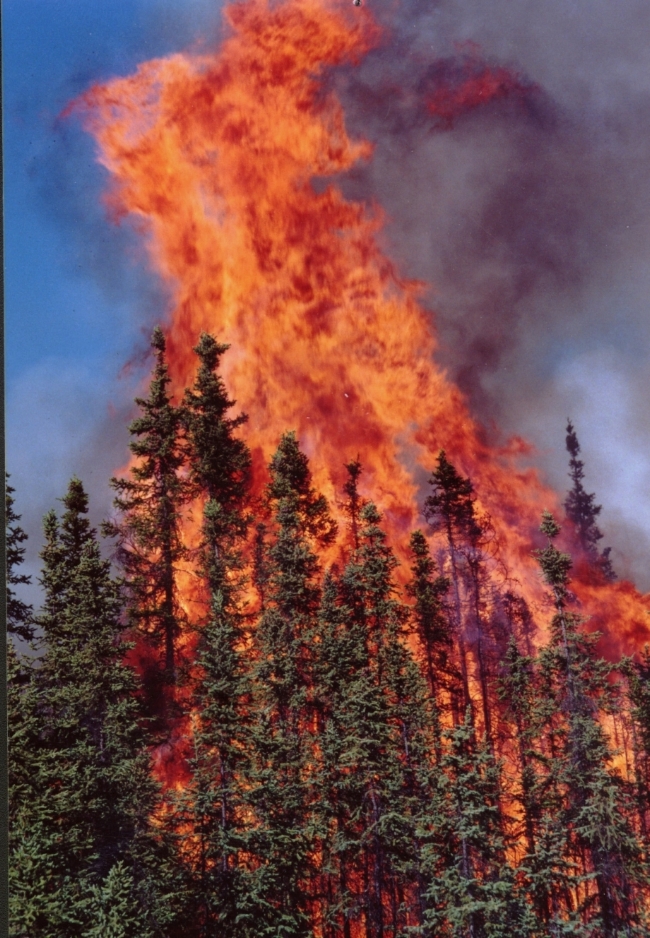
Photo credit: Terry Chapin. http://www.lternet.edu/node/49513.
Demography and genomics of outbreaking populations
Demography and Genomics of outbreaking populations
Demographic variation has major implications in spatial and temporal genetic diversity and structure, and consequently population genetic inferences, which are magnified in outbreaking systems. Thus, current models that aim to understand genetic dynamics of outbreaking populations through time and space risk making incorrect conclusions regarding landscape connectivity, dispersal capacity, and adaptation. The goal of this research theme is to challenge existing conceptual underpinnings of genetic variation, characterize how demographic context affects neutral and adaptive population genetic patterns, and to develop new approaches to address ecological, conservation, and management initiatives considering informative genetic and genomic perspectives. This work primarily focuses on outbreaking forest insect pests such as the eastern spruce budworm. However, long-lived species (e.g., turtles) also present complex demographic contexts that confound traditional approaches to population genetic inference.
Eastern spruce budworm
The eastern spruce budworm (SBW; Choristoneura fumiferana) is a lepidopteran forest pest that defoliates huge areas of spruce and fir forests during its periodic outbreaks, with major socio-economic implications. SBW outbreak dynamics are shaped by the complex interactions between climate, forest structure, competition, parasitism and predation, and dispersal. In pursuit of our research goals, we have developed robust sample and genomic libraries spanning more than a decade and covering the majority of the SBW distribution across North America, during different phases of an outbreak cycle. This project has several key themes that we are exploring to better understand the interplay between outbreak dynamics and genetic inferences:
1. Despite the important role of dispersal to the spatial dynamics of SBW outbreaks, little is known about how it varies with spatial context and over the course of an outbreak, and how it affects spatial synchrony in outbreak dynamics. This research applies tools and methods from spatial population genetics to characterize genetic connectivity among outbreak patches in the current outbreak in eastern north America.
2. Using genetic information to infer connectivity and how it varies within and among years, we will infer patterns of gene flow and dispersal across the landscape, and the influence of intervening land-cover (isolation by resistance) and local environmental conditions (isolation by environment). Concurrently, we are developing dispersal models using predicted phenology (BioSIM) and demographic data collected from pheromone traps (adult males).
3. Spatial and temporal demographic variation in non-outbreaking populations has been the origin of many population genetic concepts, which have been the standard for developing metrics and analyses for practical applications such as conservation and management. Our research is challenging the understanding of how standard protocols for analysing population genetic data can lead to incorrect conclusions when investigating the rapidly changing, extreme demography of outbreaking dynamics.
4. We are developing efficient and robust forward in time, individual based simulation models to evaluate a range of demographic scenarios to better predict and manage outbreaking populations. Using our extensive real-world SBW data, we can test the accuracy of these simulations, with the goal of developing a tool that can be adapted to other outbreaking species and scenarios.
Together, this work will increase our knowledge of how SBW demographic dynamics vary in different landscape contexts. The results can be used to inform management initiatives and improve simulation models that predict insect population dynamics and forecast future outbreak risk. This work will also address the important question of the potential efficacy of currently proposed reactive and proactive (e.g. early intervention) management strategies.
Selected Publications
Fontenelle, J. P., Larroque, J., Legault, S., Wittische, J., Underwood, J. A. R., & James, P. M. A. 2024. Multiyear Genotype Characterization of Eastern Spruce Budworm Outbreaking Populations from Quebec and Adjacent Regions. Ecology , 105(12)
Larroque J, Johns R, Canape J, Morin B, James PMA. 2020. Spatial genetic structure at the leading edge of a spruce budworm outbreak: the role of dispersal in outbreak spread. Forest Ecology and Management 461, 117965
Larroque J, Legault S, Johns R, Lumley L, Cusson M, Renaut S, James PMA. 2019. Temporal variation in spatial genetic structure during population outbreaks: distinguishing among different potential drivers of spatial synchrony. Evolutionary Applications 12(10): 1931-1945
James PMA, Cooke B, Brunet B, Lumley L, Sperling FAH, Fortin M-J, Quinn V, Sturtevant BR. 2015. Life-stage differences in spatial genetic structure in an irruptive forest insect: Implications for dispersal and spatial synchrony. Molecular Ecology. 24(2): 296-309.
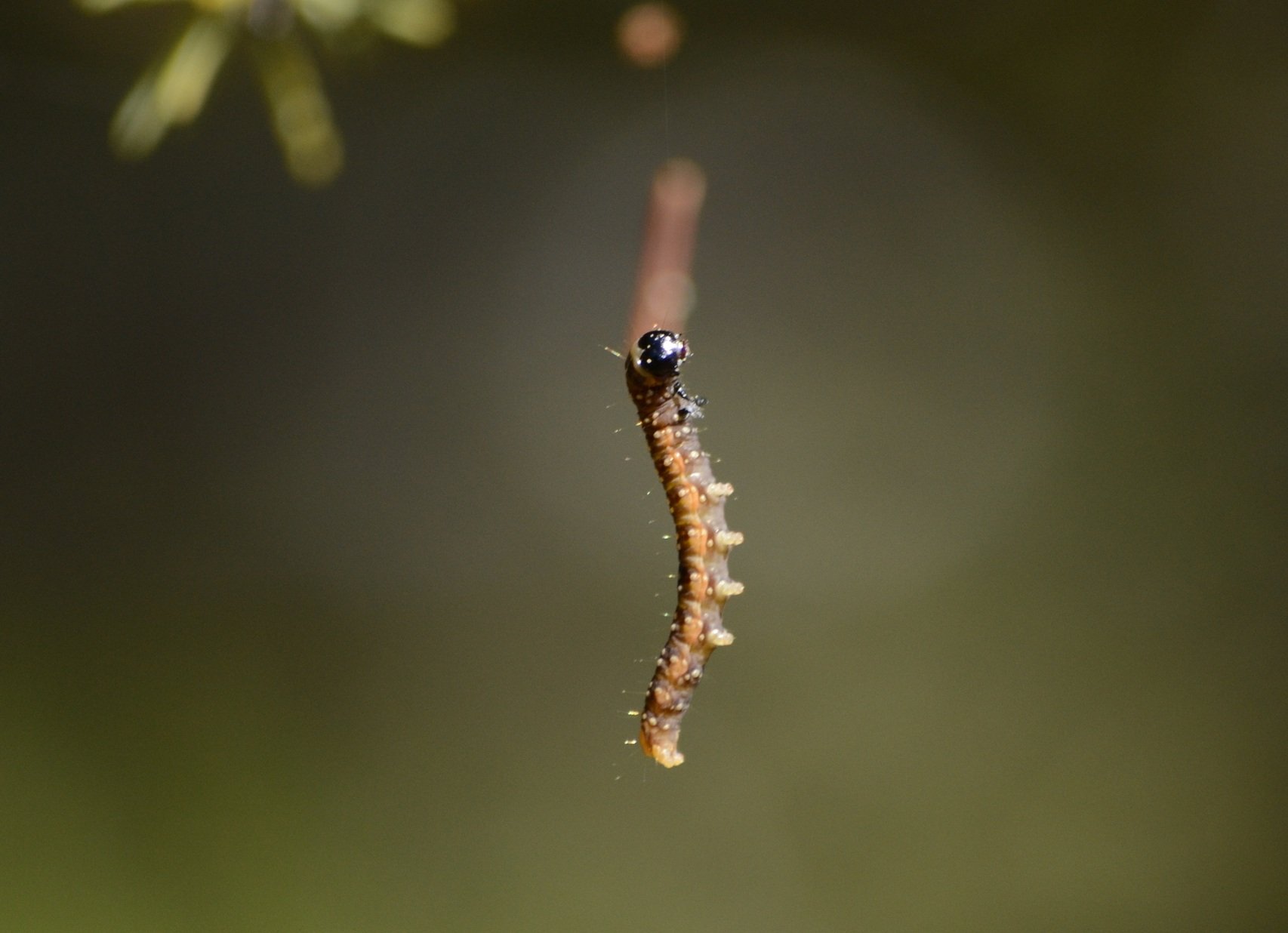
SBW larva hanging by a thread. Photo: Olivier Pontbriand-Paré
Parasitoid meta-community dynamics
Parasitoid meta-community dynamics
Theory and empirical data indicate that forest structure (i.e., composition and configuration) can affect insect population dynamics and thus has the potential to modulate the severity and extent of forest insect outbreaks. Forest structure affects population irruptions directly through the availability and connectivity of suitable host trees. However, the forest can also indirectly affect outbreaks through its effects on predator (parasitoid) community diversity, abundances, and mobility. This project combines tools and techniques from community ecology and landscape genetics to evaluate the relative contributions of direct and indirect factors on insect trophic dynamics and outbreaks. Specifically, we are evaluating the relative importance of the “silvicultural” and “natural enemies” hypothesis of spruce budworm (SBW) outbreaks.
To address this idea, SBW larvae were collected in the summer of 2014 from 30 sites across Quebec in regions currently affected by the SBW. Larvae were reared and emerged parasitoids were identified. In total, or 50 000 larvae were individually reared which provided over 7000 parasitoids of over 15 species of hymenoptera and diptera.
Current projects using these data include:
1) Assessing how forest structure affects spatial variation in parasitism rates at different spatial scales using remotely sensed data.
2) Determining the relative importance of spatial context, environmental variation, and outbreak characteristics of parasitoid community beta-diversity at broad spatial scales.
3) Investigating how climate driven phenological mismatches between SBW and parasitoids may affect future outbreak dynamics in northern forests.
4) Characterizing the spatial genetic structure and estimating dispersal capacity of two parasitoid species: Apanteles fumiferanae & Glypta fumiferanae.
5) Assessing the context-dependent drivers of community assembly in the SBW parasitoid complex.
We hope that our results will contribute to our understanding of the diversity-stability relationships in forest insects systems and to provide recommendations for spatial management strategies that will allow us to augment the control that parasitoid populations exert on outbreaking populations and thus to reduce forest losses.
Selected Publications
Legault S & James PMA. 2024. Spatial patterns of hyperparasitism along a latitudinal gradient of forest diversity: Insights from the spruce budworm-parasitoids community. Environmental Entomology. 53(1): 116-126
Legault S, Wittische J, Cusson M, Brodeur J, James PMA. 2021. Genetic evidence of large-scale population connectivity in spruce budworm parasitoids. Molecular Ecology. 30(22), 5658-5673
Marrec R, Pontbriand-Paré O, Legault S, and James PMA. 2018. Spatiotemporal variation in drivers of parasitoid metacommunity structure in continuous forest landscapes. Ecosphere 9(1):e02075. doi: 10.1002/ecs2.2075
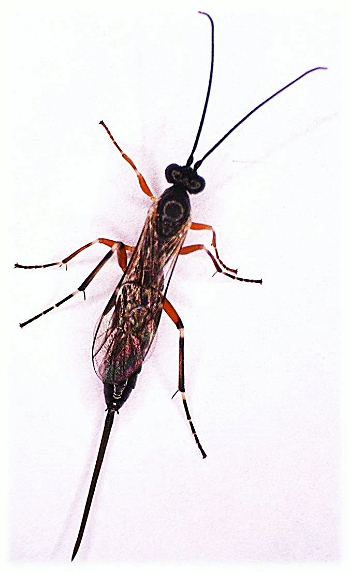
Photo credit: Simon Legault
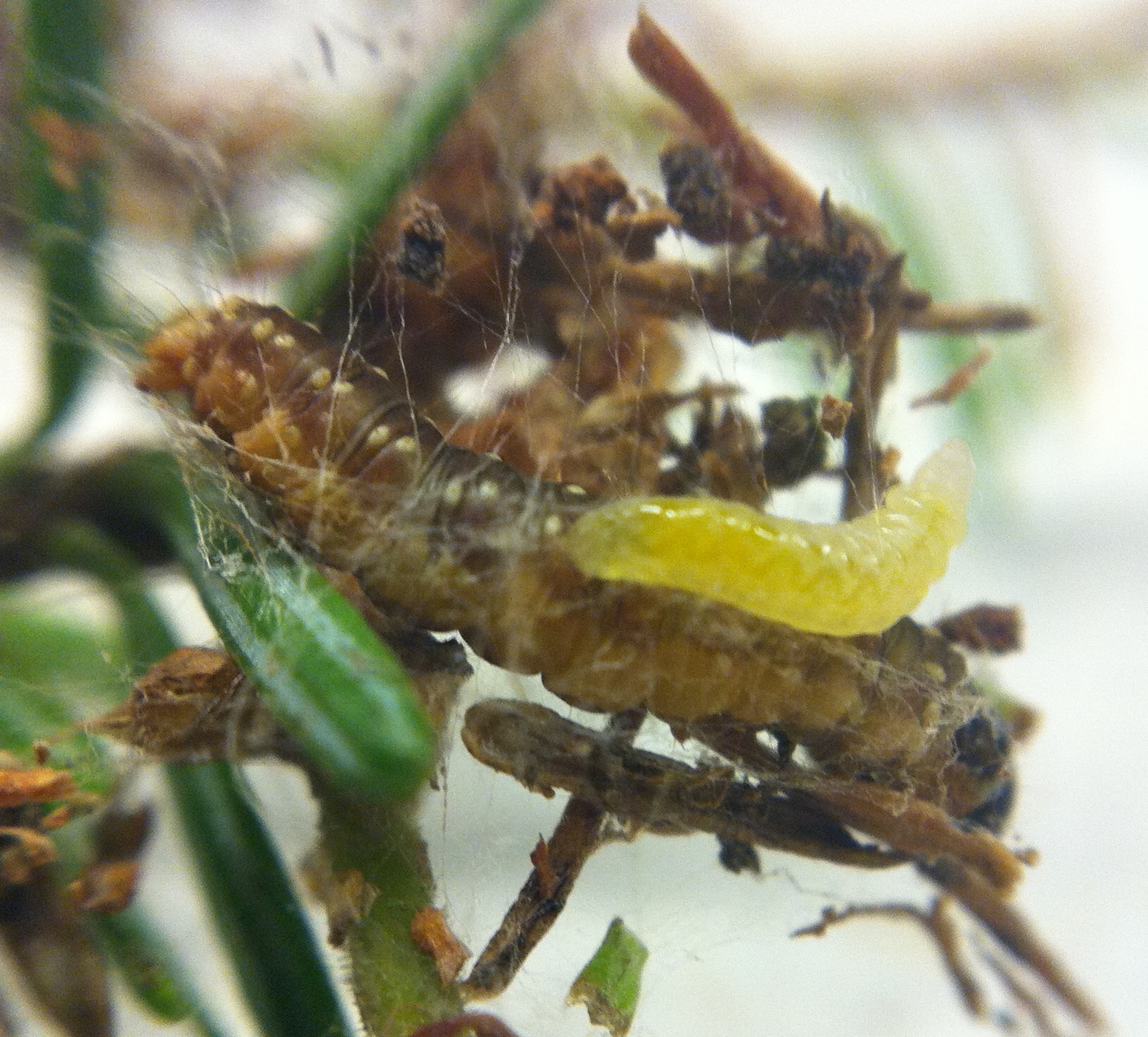
Photo credit: Simon Legault


